
A color code is a system for encoding and representing non-color information with colors to facilitate communication. This information tends to be categorical though may also be sequential.

A crown is a traditional form of head adornment, or hat, worn by monarchs as a symbol of their power and dignity. A crown is often, by extension, a symbol of the monarch's government or items endorsed by it. The word itself is used, particularly in Commonwealth countries, as an abstract name for the monarchy itself as distinct from the individual who inhabits it. A specific type of crown is employed in heraldry under strict rules. Indeed, some monarchies never had a physical crown, just a heraldic representation, as in the constitutional kingdom of Belgium.
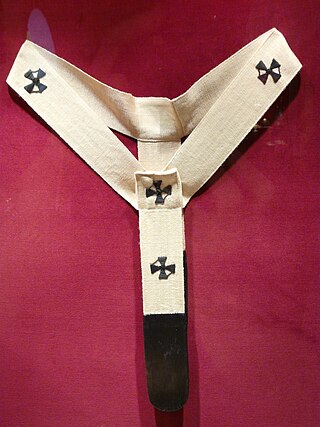
The pallium is an ecclesiastical vestment in the Catholic Church, originally peculiar to the Pope, but for many centuries bestowed by the Holy See upon metropolitans and primates as a symbol of their conferred jurisdictional authorities, and still remains a papal emblem.

The cassock or soutane is a Christian clerical clothing coat used by the clergy and male religious of the Oriental Orthodox Churches, Eastern Orthodox Church and the Catholic Church, in addition to some clergy in certain Protestant denominations such as Anglicans and Lutherans. "Ankle-length garment" is the literal meaning of the corresponding Latin term, vestis talaris. It is related to the habits traditionally worn by nuns, monks, and friars.
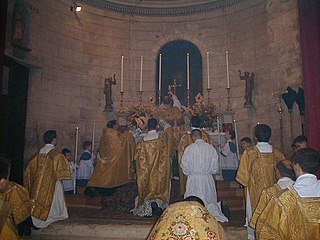
Vestments are liturgical garments and articles associated primarily with the Christian religion, especially by Eastern Churches, Catholics, Lutherans, and Anglicans. Many other groups also make use of liturgical garments; among the Reformed (Calvinist) Churches this was a point of controversy in the Protestant Reformation and sometimes since, in particular during the ritualist controversies in the Church of England in the 19th century.

A temple garment, also referred to as garments, the garment of the holy priesthood, or Mormon underwear, is a type of underwear worn by adherents of the Latter Day Saint movement after they have taken part in the endowment ceremony. Garments are required for any individual who previously participated in the endowment ceremony to enter a temple. The undergarments are viewed as a symbolic reminder of the covenants made in temple ceremonies and are seen as a symbolic and/or literal source of protection from the evils of the world.
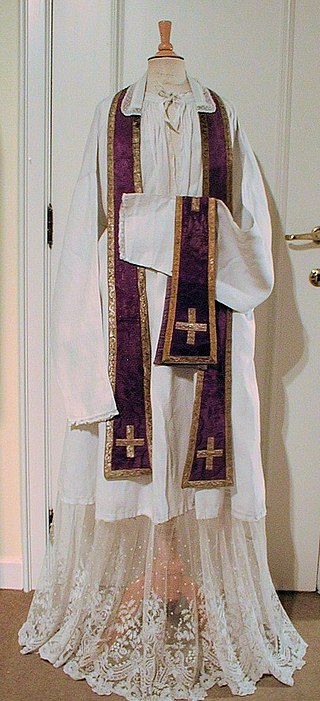
The stole is a liturgical vestment of various Christian denominations, which symbolizes priestly authority; in Protestant denominations which do not have priests but use stoles as a liturgical vestment, however, it symbolizes being a member of the ordained. It consists of a band of colored cloth, usually of silk, about seven and a half to nine feet long and three to four inches wide, whose ends may be straight or may broaden out in the shape of a spade or bell. The center of the stole is worn around the back of the neck and the two ends hang down parallel to each other in front, either attached to each other or hanging loose. The stole is almost always decorated in some way, usually with two crosses, or sometimes another significant religious design. It is often decorated with contrasting galloons and fringe is usually applied to the ends of the stole following Numbers 15:38–39. A piece of white linen or lace may be stitched onto the back of the collar as a sweat guard, which can be replaced more cheaply than the stole itself.

A belt without a buckle, especially if a cord or rope, is called a girdle in various contexts, especially historical ones, where girdles were a very common part of everyday clothing from antiquity until perhaps the 15th century, especially for women. Most girdles were practical pieces of costume to hold other pieces in place, but some were loose and essentially for decoration. Among the elite these might include precious metals and jewels.

The pulpit gown, also called pulpit robe or preaching robe, is a black gown worn by Christian ministers for preaching. It is particularly associated with Reformed churches, while also used in the Anglican, Methodist, Lutheran and Unitarian traditions.
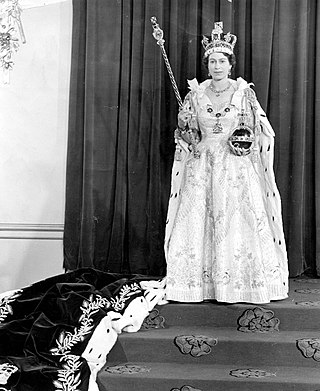
Regalia is the set of emblems, symbols, or paraphernalia indicative of royal status, as well as rights, prerogatives and privileges enjoyed by a sovereign, regardless of title. The word originally referred to the elaborate formal dress and accessories of a sovereign, but now it also refers to any type of elaborate formal dress. The word stems from the Latin substantivation of the adjective regalis, "regal", itself from rex, "king". It is sometimes used in the singular, regale.

Papal regalia and insignia are the official items of attire and decoration proper to the Pope in his capacity as the visible head of the Catholic Church and sovereign of the Vatican City State.
Clerical clothing is non-liturgical clothing worn exclusively by clergy. It is distinct from vestments in that it is not reserved specifically for use in the liturgy. Practices vary: clerical clothing is sometimes worn under vestments, and sometimes as the everyday clothing or street wear of a priest, minister, or other clergy member. Eastern Orthodox clerical clothing is a subset of a monk's habit.
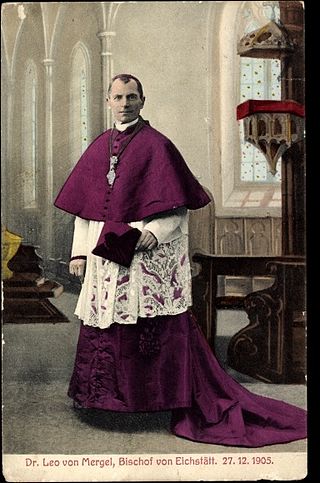
Choir dress is the traditional vesture of the clerics, seminarians and religious of Christian churches worn for public prayer and the administration of the sacraments except when celebrating or concelebrating the Eucharist. It differs from the vestments worn by the celebrants of the Eucharist, being normally made of fabrics such as wool, cotton or silk, as opposed to the fine brocades used in vestments. It may also be worn by lay assistants such as acolytes and choirs. It was abandoned by most of the Protestant churches that developed from the sixteenth-century Reformation.

Ceremonial dress is clothing worn for very special occasions, such as coronations, graduations, parades, religious rites, trials and other important events. In the western dress code hierarchy of dress codes, ceremonial dress is often considered one of the most formal, in other cultures ceremonial dresses vary widely having entirely different meanings, and styles.

Byzantine dress changed considerably over the thousand years of the Empire, but was essentially conservative. Popularly, Byzantine dress remained attached to its classical Greek roots with most changes and different styles being evidenced in the upper strata of Byzantine society always with a touch of the Hellenic environment. The Byzantines liked colour and pattern, and made and exported very richly patterned cloth, especially Byzantine silk, woven and embroidered for the upper classes, and resist-dyed and printed for the lower. A different border or trimming round the edges was very common, and many single stripes down the body or around the upper arm are seen, often denoting class or rank. Taste for the middle and upper classes followed the latest fashions at the Imperial Court.
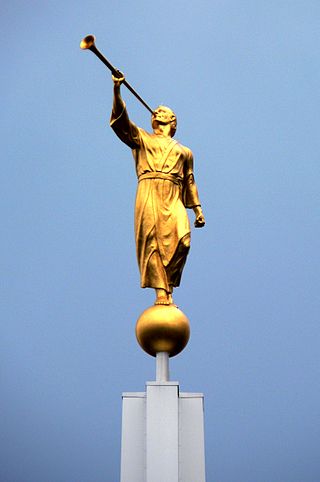
Symbolism in the Church of Jesus Christ of Latter-day Saints is the process whereby objects or actions have been invested with an inner meaning expressing church ideas. The Church of Jesus Christ of Latter-day Saints and its membership have adopted a number of symbols that differ from those typically used in Christianity.
Symbolic behavior is "a person’s capacity to respond to or use a system of significant symbols". The symbolic behavior perspective argues that the reality of an organization is socially constructed through communication. Symbolic messages are used by individuals to understand their environment and create a social reality. When faced with uncertainty, individuals continually organize themselves within their group based reality and respond within that reality.

Hmong Textile Art consists of traditional and modern textile arts and crafts produced by the Hmong people. Traditional Hmong textile examples include hand-spun hemp cloth production, basket weaving, batik dyeing, and a unique form of embroidery known as flower cloth or Paj Ntaub in the Hmong language RPA. The most widely recognized modern style of Hmong textile art is a form of embroidery derived from Paj Ntaub known as story cloth.
Religious clothing is clothing which is worn in accordance with religious practice, tradition or significance to a faith group. It includes clerical clothing such as cassocks, and religious habit, robes, and other vestments. Accessories include hats, wedding rings, crucifixes, etc.

Yunjian, also known as Cloud collar in English and sometimes referred as châr-qâb, is a Chinese term which can either to a four-lobed motif, or to a traditional Chinese garment accessory item in Hanfu, the Traditional clothing of the Han Chinese, which is typically found in the form of a detachable collar with cloud patterns and is worn over the shoulders area, similar to a shawl. As an garment accessory, the yunjian is also typically found in four-lobed design although multi-lobed design also existed throughout history. The yunjian could also be applied directly on garments, where it would fall around the collar of robes onto the chest and shoulder region,or as a clothing appliqué. In China, the yunjian has both ceremonial and practical uses when used in clothing. As a garment item, the yunjian was an important clothing element for Chinese women, especially in the Ming and Qing dynasties; its usage was spread across China where it became associated with the Han Chinese's wedding clothing. In Henan, brides would wear yunjian decorated with hanging ribbons and bells. It also had the practical use of preventing clothing from being dirty and oily by covering up the clothes and by covering up the stains. The yunjian is used in Peranakan wedding; the multi-layered yunjian worn by Chinese brides on the day of their wedding is sometimes known as "phoenix collar". The yunjian also started to be worn by the Non-Chinese, the Tartars of northern China and Manchuria in the later medieval period.

















